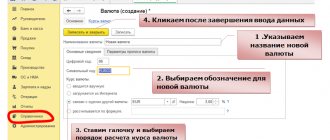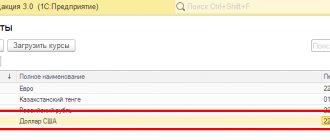Introductory information
Let’s make a reservation right away: the algorithm below for reflecting exchange rate differences in tax accounting applies to supplies dated 2015 and later periods.
Previously, different rules were in force, according to which, for “foreign exchange” supplies paid in rubles, accountants showed in tax accounting not exchange rate, but amount differences (see “Starting 2015, tax and accounting rules will be brought closer to each other”). We would like to add that the amount differences on transactions concluded before 2015 must be reflected according to the previous rules. Accounting for exchange rate differences by the supplier depends on the moment at which the buyer paid for the delivery. Let's take a closer look at three possible options.
Invoice in euros, payment in rubles: sample and filling out the form
Invoice in euros (payment in rubles) - the sample is not a primary accounting document. Therefore, there is no unified form of a specific format.
However, it is important to correctly enter the necessary information into the sample invoice in euros.
The account must be assigned a unique number. The date of issue must be indicated in the title of the invoice. It is also important to indicate information about VAT, since the taxation of the transaction depends on this.
The form must include the following information:
- Date of presentation of invoice;
- Document Number;
- Full name of the payer;
- Name, legal address and identifying information of the recipient;
- Recipient's bank account details;
- Price per unit of goods;
- Total cost of delivery;
- VAT information.
The type of invoice currency in this case is indicated in euros.
If an exchange rate difference occurs during the period from shipment to payment, you need to draw up an agreement to increase the contract value and an adjustment invoice. The possibility of paying such a difference must be indicated in the supply agreement.
Option one: payment received after shipment
The seller converts the proceeds from the delivery, the cost of which is expressed in currency or conventional units, into rubles. According to accounting standards, the seller must use the exchange rate that is established on the date of shipment. This follows from paragraph 6 of PBU 3/2006 “Accounting for assets and liabilities, the value of which is expressed in foreign currency” (approved by order of the Ministry of Finance of Russia dated November 27, 2006 No. 154n). In tax accounting, revenue is also recalculated at the exchange rate on the date of shipment (clause 8 of Article 271 of the Tax Code of the Russian Federation)*.
Next, the supply receivables must be adjusted up or down, depending on how the exchange rate changes. Adjustments are made through exchange rate differences.
The moment and procedure for determining exchange rate differences in tax and accounting are the same. This follows from paragraph 8 of Article 271 of the Tax Code of the Russian Federation, paragraph 10 of Article 272 of the Tax Code of the Russian Federation and the provisions of PBU 3/2006. Thus, the exchange rate difference is formed on the last day of each month until full payment is made. Plus, the exchange rate difference is formed at the time of payment, both full and partial.
The exchange rate difference on the last day of each month is the cost of the unpaid part of the delivery in foreign currency or monetary units, multiplied by the difference between the two rates. The first rate is on the date of the previous recalculation (if there have been no recalculations yet, then on the delivery date). The second course is for the current date, that is, the last day of the month.
The exchange rate difference at the time of payment consists of two parts. To find the first part, you need to take the cost of part of the delivery (in foreign currency or cu), which is paid by the buyer. To find the second part, you need to take the cost of the remaining unpaid part of the delivery in foreign currency or cu. The first and second values must be multiplied by the difference between the two rates: on the date of the previous recalculation (if there have been no recalculations yet, then on the delivery date) and on the date of payment.
If the exchange rate has decreased since the previous recalculation (or delivery), then the resulting difference is negative. In tax and accounting, it should be written off as non-operating expenses (subclause 5, clause 1, article 265 of the Tax Code of the Russian Federation and clause 13 of PBU 3/2006).
If the exchange rate has increased since the previous recalculation (or delivery), then the resulting difference is positive. In tax and accounting, it must be taken into account in non-operating income (subclause 11 of article 250 of the Tax Code of the Russian Federation and clause 13 of PBU 3/2006).
Particular attention should be paid to value added tax. The taxable base for VAT is formed once - at the time of shipment. The base is equal to the cost of delivery, calculated at the exchange rate on the date of shipment. Upon subsequent payment, the VAT base is not adjusted, even if the exchange rate changes (clause 4 of Article 153 of the Tax Code of the Russian Federation). As for exchange rate differences - both positive and negative - they are included in income and expenses along with tax.
Example 1
In March 2015, Alpha LLC shipped to Betta LLC a batch of goods with a total value of 118,000 conventional units (including VAT 18% - 18,000 USD). The exchange rate on the date of shipment was 45 rubles/cu. The exchange rate as of March 31 was 42 rubles/cu.
In April 2015, Betta partially paid for the goods by transferring 40,000 USD to Alpha. at the rate of 40 rubles/cu. The exchange rate as of April 30 was 38 rubles/cu.
In May 2015, Betta finally paid for the goods, transferring the remaining 78,000 USD. at the rate of 35 rubles/cu.
Alpha's accountant reflected these transactions as follows.
In March, on the date of shipment, he made the following entries: DEBIT 62 CREDIT 90 - 5,310,000 rubles. (118,000 c.u. x 45 rub./c.u.) - revenue is shown; DEBIT 90 CREDIT 68 – 810,000 rub. (18,000 c.u. x 45 rub./c.u.) - VAT payable has been accrued; In tax accounting, sales income was generated in the amount of RUB 5,310,000. On March 31, the accountant made the following entry: DEBIT 91 CREDIT 62 - 354,000 rubles. (118,000 c.u. x (45 rub./c.u. – 42 rub./c.u.) - a negative exchange rate difference is reflected when recalculating accounts receivable at the rate on the last day of the month. In tax accounting, a non-operating expense was formed in in the amount of RUB 354,000. In April, on the date of receiving money from Betta, the accountant made the following entries: DEBIT 51 CREDIT 62 – RUB 1,600,000 (CU 40,000 x RUR 40/CU) - partial payment received from Betta LLC; DEBIT 91 CREDIT 62 – 80,000 rub. (40,000 cu. x (42 rub./cu. – 40 rub./cu.) - negative exchange rate difference is reflected when recalculating the amount payment at the rate on the day of payment; DEBIT 91 CREDIT 62 – 156,000,000 rubles ((118,000 cu. – 40,000 cu.) x (42 rub./c.u. – 40 rub./c.u. e.) — a negative exchange rate difference is reflected when recalculating the balance of accounts receivable at the exchange rate on the day of payment.
In tax accounting, a non-operating expense was created in the amount of 236,000 rubles (80,000 rubles + 156,000 rubles). On April 30, the accountant made the following entry: DEBIT 91 CREDIT 62 – 156,000 rubles. ((118,000 c.u. – 40,000 c.u.) x (40 rub./cu. – 38 rub./c.u.) - reflects the negative exchange rate difference when recalculating the balance of receivables at the exchange rate for the last day of the month. In tax accounting, a non-operating expense was created in the amount of RUB 156,000. In May, the accountant made the following entries: DEBIT 51 CREDIT 62 – RUB 2,730,000 (CU 78,000 x 35 RUR/CU) - received final payment from Betta LLC; DEBIT 91 CREDIT 62 - 234,000 rubles (78,000 cu. x (38 rub./cu. - 35 rub./cu.) - negative exchange rate difference reflected when recalculating the payment amount at the exchange rate on the day of payment.
Tax accounting shows non-operating expenses in the amount of 234,000 rubles.
Sale of goods under a contract linked to currency equivalent or conventional monetary units
RECOGNITION OF AMOUNT DIFFERENCES IN ACCOUNTING
Often, trading organizations, trying to eliminate the adverse consequences of instability of the national currency, set the contract price in foreign currency (or conventional monetary units). This possibility is provided for in paragraph 2 of Article 317 of the Civil Code of the Russian Federation (hereinafter referred to as the Civil Code of the Russian Federation), according to which, a monetary obligation may stipulate that it is payable in rubles in an amount equivalent to a certain amount in foreign currency or in conventional monetary units. In this case, the amount payable in rubles is determined at the official exchange rate of the relevant currency or conventional monetary units on the day of payment, unless a different rate or the date of its determination is established by law or by agreement of the parties. In accordance with paragraph 1 of Article 140 of the Civil Code of the Russian Federation, the legal means of payment, obligatory for acceptance at face value throughout the Russian Federation, is the ruble. Consequently, all cash and non-cash payments on the territory of the Russian Federation must be carried out in rubles, except in cases specifically established by law.
The parties to the agreement independently determine on what day the price of the agreement is recalculated in ruble equivalent, therefore, the price of the agreement will be determined based on the foreign exchange rate valid on the date agreed upon by the parties to the agreement.
Usually, when concluding a contract, the seller and buyer set the following dates for recalculating the price in ruble equivalent:
· based on the foreign currency exchange rate on the day the buyer pays for the goods;
· based on the foreign currency exchange rate on the day of transfer of ownership of the goods to the buyer, otherwise, on the day of shipment.
Note that, as a rule, as the date of conversion into national currency of an obligation expressed in foreign currency, business entities set the date of payment for shipped goods; The following courses apply:
· official exchange rate of the Central Bank of the Russian Federation;
· rate (purchase or sale) of a certain currency exchange;
· exchange rate of the Central Bank of the Russian Federation or a currency exchange, increased (decreased) by a certain percentage;
· any other ratio of foreign currency and ruble agreed upon by the parties to the transaction.
When expressing a liability in foreign currency or conventional monetary units, it is necessary to distinguish between the currency of the debt and the currency of payment. The debt currency is the monetary units in which the economic value of the obligation is represented (foreign currency or conventional monetary units), and the payment currency is the monetary units in which the obligation is fulfilled (national currency - rubles).
Example 1.
If the rate of the Central Bank of the Russian Federation on the date of payment is 29.7 rubles per 1 US dollar, then the condition “payment at the rate of the Central Bank of the Russian Federation + 3%” means that the transaction should apply the rate of 30.59 rubles per 1 US dollar (29.7 / 100% x 103% = 30.59).
End of the example.
Note!
Since funds are credited to the settlement account of the recipient (seller) 1-2 days from the date of their transfer from the payer’s (buyer’s) settlement account, therefore, the agreement of the parties must specifically stipulate that the date of payment should be considered the day the funds are debited from the payer’s settlement account (buyer).
If the procedure for determining the payment date stipulates that the payment date is the day the bank credits funds to the recipient’s (seller’s) current account, then the situation will develop as follows: the payer (buyer) will not be able to pay the full amount of his obligations, since at the time of preparing the payment document, he will not know the day the counterparty to the transaction received the money and the foreign currency exchange rate at that point in time.
If the parties do not agree at all on the procedure for determining the payment date, then the following situation may arise: the payer (buyer) will determine the rate by the date the bank writes off money from his current account, and the recipient (seller) will determine the rate by the date the bank credits the money to his current account. check. As a result, in order to liquidate the outstanding portion of the debt to the seller, which was formed as a result of a temporary gap in the recalculation of funds, the buyer will be forced to make additional payments.
Example 2.
According to the terms of the purchase and sale agreement, the buyer must pay the seller for the goods an amount in rubles equivalent to 100,000 US dollars (including VAT - 18%), at the exchange rate of the Central Bank of the Russian Federation at the time of payment. The moment of transfer of ownership is the shipment of goods. Since the parties to the transaction did not specify the procedure for determining the moment of payment, the buyer determined the payment date at the time the bank withdraws money from his current account (February 3, 2005), and the seller determined the payment date at the time the money arrived in his current account (February 4, 2005) . The exchange rate of the Central Bank of the Russian Federation on February 3, 2005 was 28.5252 rubles per 1 US dollar, and on February 4, 2005 – 28.6205 rubles per 1 US dollar.
As a result, discrepancies arose in settlements between the seller and the buyer:
The seller used the day the money was received in his current account as the date of recalculation. According to him, the buyer should have received an amount of 2,862,050 rubles (28.6205 rubles x $100,000). The buyer transferred the amount of 2,852,520 rubles (28.5252 rubles x $100,000).
Thus, according to the seller, the buyer owed him an amount in rubles equivalent to 332.98 US dollars, which is 9,530 rubles as of February 4.
End of the example.
As can be seen from the example, the procedure for determining the payment date, fixed by the parties to the agreement, is of significant importance.
If the exchange rate of a foreign currency against the ruble on the established date of conversion increases compared to its value on the date of shipment of goods, the seller will receive additional income, since the buyer will transfer to the seller an amount exceeding the cost of the goods calculated at the time of their shipment.
If the exchange rate of a foreign currency against the ruble during the period between the shipment of goods and payment for them decreases, the buyer will pay less than he would have paid at the cost formed at the time of shipment of the goods.
If the contract stipulates that the goods are subject to payment under the terms of a currency clause, then for the buyer the purchase price of the goods will represent the amount actually paid to the supplier in rubles. Thus, the cost of goods determined at the time of their acceptance for accounting is (in the case of subsequent payment) the preliminary purchase value. The final purchase price of goods is formed only after full settlement with the supplier. This provision fully complies with the requirements of paragraph 1 of Article 11 of the Federal Law of November 21, 1996 No. 129-FZ “On Accounting”, which establishes that the assessment of property acquired for a fee is carried out by summing up the actual expenses incurred for its purchase. Consequently, any asset purchased for a fee must be accounted for at the actual cost of its purchase. The amount of payment (disposal of an asset) is determined from the price and conditions established by the agreement between the organization and its counterparty (clause 6.1 of PBU 10/99, approved by Order of the Ministry of Finance of the Russian Federation dated May 6, 1999 No. 33n “On approval of the Accounting Regulations “Expenses of the Organization” PBU 10/99″ (hereinafter referred to as PBU 10/99).
For the seller, sales turnover will be the total amount of funds received. The amount of receipts and (or) receivables is determined based on the price established by the agreement between the trade organization and the buyer (clause 6.1 of PBU 9/99, approved by Order of the Ministry of Finance of the Russian Federation dated May 6, 1999 No. 32n “On approval of the Accounting Regulations “Organization’s Income” "PBU 9/99" (hereinafter referred to as PBU 9/99)).
Thus, the peculiarity of a transaction concluded under a currency clause is that the final formation of the purchase (sale) price of goods occurs only after full settlement.
In their economic essence, amount differences represent a change in the purchasing power of the currency of payment between the dates of acceptance for balance sheet accounting (shipment) and payment for purchased (sold) values.
It should be noted that when establishing the contract price in conventional monetary units (foreign currency), amount differences in the accounting of the seller and the buyer do not always arise.
This occurs in cases where during the execution of the contract there was no change in the exchange rate of the ruble in relation to the conventional monetary unit (foreign currency). Or in a situation where payment and shipment of goods occur simultaneously.
At the same time, other options are possible when the contract price is expressed in conventional monetary units (foreign currency), but no amount differences arise for any of the parties to the contract.
The occurrence or absence of amount differences is related to the terms of the contract and depends on the following established by the parties to the contract:
· the date on which the ruble equivalent of the price of goods is determined;
· payment procedure (including the availability of advance payment);
· the moment of transfer of ownership of the goods sold;
· other terms of the contract that affect the recalculation of the ruble equivalent of the contract price (in particular, a complex algorithm for establishing the contract price, for example, taking into account discounts for sales volume).
The occurrence of amount differences for the seller depends on what happened first: the shipment of goods or their payment. When receiving advance payment for goods (this happens often in wholesale trade), the seller should be guided by paragraph 3 of PBU 9/99, according to which advance payment is not recognized as income (revenue). In the case of full prepayment in accordance with the terms of the agreement, in which the date for determining the foreign currency exchange rate is the day of payment, the price of the goods sold in ruble equivalent on the date of recognition of revenue in accounting (date of shipment) coincides with the ruble valuation of this product at the time of prepayment. Thus, the seller does not have any amount differences when receiving full advance payment for the goods sold.
If the advance payment is not received by the seller in full, or if the buyer pays for goods sold later than shipment, then the seller, depending on the increase or decrease in the exchange rate, experiences positive or negative amount differences. Positive amount differences increase the income of the seller (supplier), and negative ones decrease it (clause 6.6 of PBU 9/99).
Amount differences arising from the sale of goods related in accounting to income and expenses from ordinary activities, in accordance with Order of the Ministry of Finance of Russia dated October 31, 2000 No. 94n “On approval of the Chart of Accounts for accounting of financial and economic activities of enterprises and Instructions for its application” , are reflected in account 90 “Sales”. At the same time, the debt to the budget for value added tax is adjusted.
The sale of goods under the terms of a currency clause and the accrual of VAT payable to the budget is reflected by the entry:
| Account correspondence | ||
| Debit | Credit | |
| 62 | 90-1 | Revenue from the sale of goods is reflected based on the foreign currency exchange rate or conventional monetary unit at the time of shipment of the goods |
| VAT “on shipment” | ||
| 90-3 | 68 | VAT is charged and payable to the budget based on the cost of the goods at the time of shipment |
| VAT “on payment” | ||
| 90-3 | 76 | VAT is charged and payable to the budget based on the cost of the goods at the time of shipment |
If on the date of payment for previously shipped goods under a transaction under the terms of a currency clause, there was a change in the exchange rate of foreign currency or a conventional monetary unit, then the seller must adjust the proceeds and, accordingly, the amount of VAT previously calculated based on the sales price at the time of shipment of the goods.
Note!
These accounting entries are made in the usual way (if the payment currency rate in relation to foreign currency or conventional monetary units has decreased) or using the “red reversal” method (if the payment currency rate has increased).
This is reflected in accounting as follows:
| Account correspondence | ||
| Debit | Credit | |
| An entry is made when, on the date of recalculation of liabilities, the exchange rate of a foreign currency or conventional monetary unit has increased | ||
| 62 | 90-1 | Revenue was adjusted due to an increase in the exchange rate of foreign currency or conventional monetary unit |
| VAT “on shipment” | ||
| 90-3 | 68 | Accrual (adjustment) of VAT payable to the budget |
| VAT “on payment” | ||
| 90-3 | 76 | Accrual (adjustment) of VAT payable to the budget |
| An entry is made when, on the date of recalculation of the liability, the exchange rate of a foreign currency or conventional monetary unit has decreased | ||
| 62 | 90-1 | REVERSE! Revenue was adjusted due to a depreciation of foreign currency or conventional monetary unit |
| VAT “on shipment” | ||
| 90-3 | 68 | REVERSE! Accrual (adjustment) of VAT payable to the budget |
| VAT “on payment” | ||
| 90-3 | 76 | REVERSE! Accrual (adjustment) of VAT payable to the budget |
Note!
The Letter of the Ministry of Finance of Russia dated July 8, 2004 No. 03-03-11/114 “On the taxation of amount differences” states that in the event of a negative amount difference, the amounts of accrued VAT are not adjusted under the shipping accounting policy. However, in our opinion, this position is not entirely legal. In this case, tax department specialists turn to the provisions of Article 162 of the Tax Code of the Russian Federation. This article only provides for an increase in the tax base for all amounts of funds received related to payment for goods (work, services) sold. Hence the conclusion that positive amount differences increase the tax base for VAT, while negative ones do not affect the amount of tax. That is, in the event of negative amount differences, the tax base calculated at the foreign currency exchange rate on the date of shipment is not subject to adjustment. Let's see how legal it is to apply Article 162 of the Tax Code of the Russian Federation (hereinafter referred to as the Tax Code of the Russian Federation) in relation to amount differences? Is it possible to consider the amount differences arising during settlements under contracts concluded in conventional units as amounts associated with payment for goods (work, services) sold? This approach does not seem entirely justified. Amount differences are not “amounts associated with payment for goods sold,” but an integral part of the cost of shipped products. This is a cost deviation that is identified when the final price is formed under the terms of the contract. And the cost of shipped goods (work, services), which was reflected in accounting on the date of shipment, is only a preliminary assessment of the subject of the contract. We are allowed to calculate VAT using the preliminary tax base by paragraph 2 of Article 153 of the Tax Code of the Russian Federation, according to which income is taken into account if it is possible to estimate it and to the extent that it can be estimated. Under contracts drawn up in conventional monetary units, this possibility exists. The income received by the supplier can first be determined by the foreign exchange rate on the day of shipment, this is a preliminary estimate of income. And later, at the time of receiving money from the buyer, the seller will have the opportunity to determine the final amount of income. That is, he must again apply the norms of paragraph 2 of Article 153 of the Tax Code of the Russian Federation and evaluate the income received, but in a different “measure” - at the rate of the corresponding foreign currency on the day of payment.
Since the total amount of VAT payable to the budget is calculated based on the results of each tax period, taking into account all changes that increase or decrease the tax base in the corresponding tax period (clause 4 of Article 166 of the Tax Code of the Russian Federation), in the case where, under the terms of the contract, payment for goods ( works, services) is produced in rubles in an amount equivalent to the amount in foreign currency (conventional monetary units), the tax base for VAT should be determined taking into account the amount differences, as amounts that increase or decrease revenue from the sale of goods (works, services).
This is exactly the position expressed in the Letter of the Ministry of Taxes and Taxes of Russia dated May 31, 2001 No. 03-1-09/1632/03-P115 “On the procedure for accounting for value added tax on amount differences.” As you can see, the positions are completely different.
In our opinion, the point of view of the Ministry of Taxes, with the accounting policy of “payment”, and the point of view of the Ministry of Finance, with the accounting policy of “shipment”, are more justified. Confirmation can also be the situation that develops with the buyer (customer) when he purchases goods (work, services) subject to VAT, and uses his right to reduce the calculated amount of tax by tax deductions established by the Tax Code of the Russian Federation, defined as the amount of VAT presented to the taxpayer and paid by him when purchasing goods (works, services) on the territory of the Russian Federation.
Paragraph 2 of Article 171 of the Tax Code of the Russian Federation stipulates that tax amounts presented to the taxpayer and paid by him upon the acquisition of goods (work, services) are subject to deduction after registration of these goods (work, services), provided that they are used to carry out transactions recognized objects of taxation. Thus, in the case when, in accordance with the concluded agreement, payment for goods (work, services), calculated on the basis of conventional monetary units, is made in Russian rubles, the entire amount of tax actually paid to the supplier must be deducted from the taxpayer. This means that the difference arising as a result of setting the contract price based on the exchange rate of a conventional monetary unit or foreign currency (total difference) may increase or decrease the amounts to be included in tax deductions.
Example 3.
Saturn LLC, in accordance with the concluded agreement, sold goods whose cost was 11,800 US dollars, including VAT of 1,800 US dollars. Title passes to the buyer at the time of shipment (February 2, 2005). Payment by the buyer was made on February 7, 2005. The cost of goods sold is 250,000 rubles. In accordance with the terms of the contract, payment for goods is made in rubles at the exchange rate of the Central Bank of the Russian Federation in effect on the date of payment.
The official US dollar exchange rate was:
-February 2, 2005 – 27.96 rubles/dollar;
-February 7, 2005 – 27.98 rubles/dollar;
The following entries have been made in the accounting records of Saturn LLC:
| Account correspondence | Amount, rubles | ||
Many Russian firms prefer to enter into commercial contracts with domestic partners in foreign currency. Legislatively, this possibility is provided for by Federal Law No. 173-FZ “On Currency Regulation and Control” of December 10, 2003. However, it is prohibited to make payments under an agreement between residents of the Russian Federation in euros and dollars (Article 9 of Law No. 173-FZ).
Residents and non-residents can pay bills in foreign currency (Article 6 of Law No. 173-FZ). Therefore, all payments for contractual obligations between domestic companies are made in Russian rubles.
Option two: payment was received before shipment took place
In the case of 100% prepayment, proceeds from sales of supplies, the cost of which is expressed in foreign currency or monetary units, are determined at the time of receipt of money at the exchange rate on the date of prepayment. Subsequently, during shipment, no adjustments are made, and exchange rate differences are not generated. In accounting, this rule is enshrined in paragraph 9 of PBU 3/2006. In tax accounting, the rule on the absence of exchange rate differences when making advance payments is stated in subparagraph 11 of Article 250 of the Tax Code of the Russian Federation and in subparagraph 5 of paragraph 1 of Article 265 of the Tax Code of the Russian Federation.
The tax base for VAT is also formed once - at the time of receipt of the advance payment at the exchange rate on the date of the advance payment. At the time of shipment, the base, as well as the amount of tax payable, are not recalculated. The Federal Tax Service of Russia recently reminded us of this in letter No. ED-4-3/12813 dated July 21, 2015 (see “The Federal Tax Service clarified the procedure for issuing invoices under foreign exchange agreements”).
Example 2
According to the agreement, Wholesaler LLC must supply products worth 236,000 USD to Magazin LLC. (including VAT 18% – 36,000 USD). In turn, the “Store” undertakes to make a 100% prepayment.
In July 2015, “Store” transferred 236,000 USD to the account of “Wholesaler”. at the rate of 55 rubles/cu.
In August 2015, “Wholesaler” shipped all the goods to “Store”. The exchange rate on the date of shipment was 60 rubles/cu.
The wholesaler's accountant reflected these transactions as follows: In July, he made the following entries: DEBIT 51 CREDIT 62 – 12,980,000 rubles. (236,000 c.u. x 55 rub./c.u.) - 100 percent prepayment was received from Magazin LLC; DEBIT 76 CREDIT 68 – 1,980,000 rub. (36,000 c.u. x 55 rub./c.u.) - VAT is charged on the prepayment. In August, the accountant made the following entries: DEBIT 62 CREDIT 90 - 12,980,000 rubles. — revenue from the shipment of goods is shown; DEBIT 90 CREDIT 68 – 1,980,000 rub. — VAT is charged on sales; DEBIT 68 CREDIT 76 – 1,980,000 rub. — VAT previously accrued on the advance payment has been accepted for deduction.
Tax accounting reflects income from sales in the amount of RUB 12,980,000.
The accountant did not make any recalculations or adjustments due to exchange rate changes.






